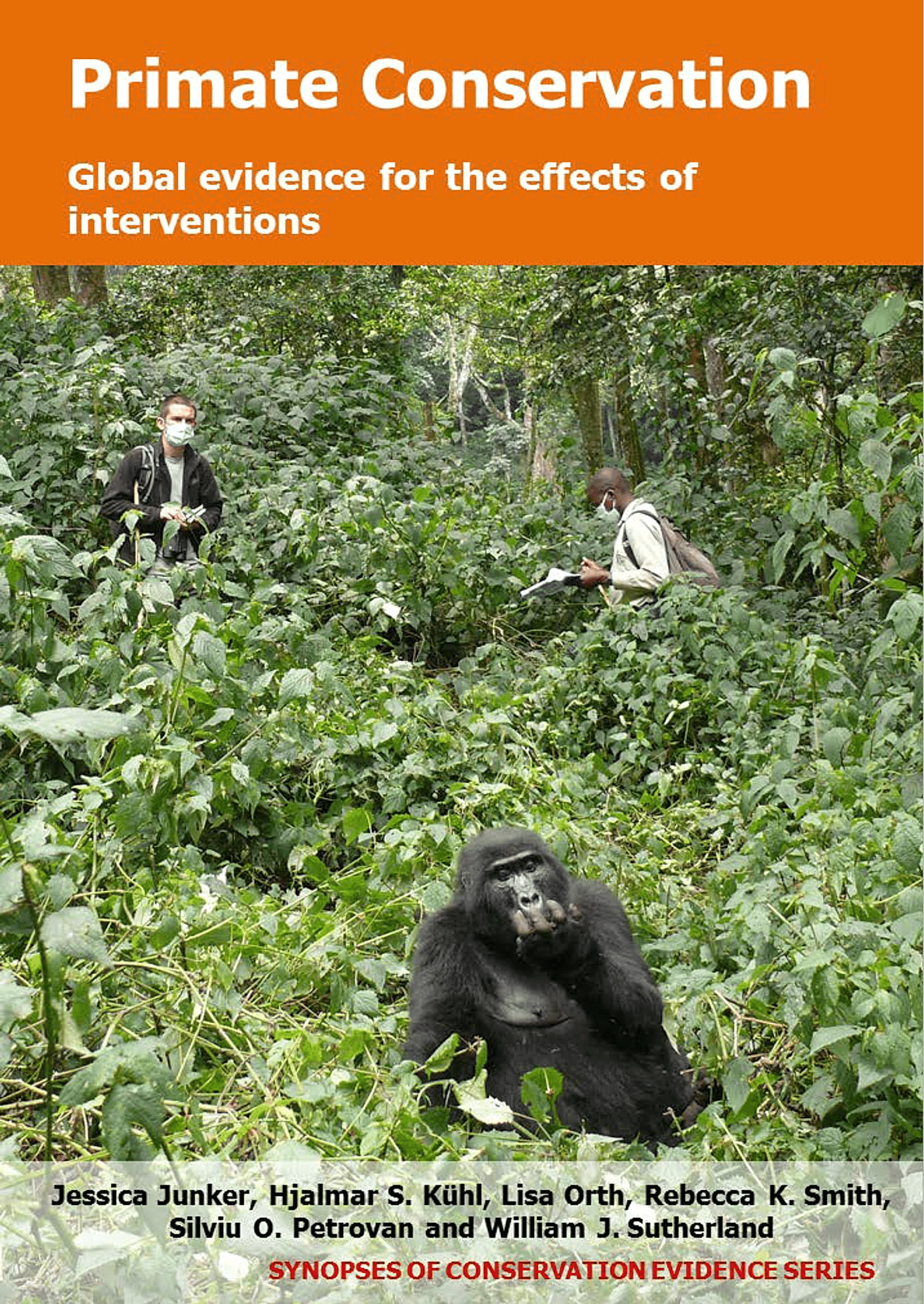Actions to conserve biodiversity
We have summarised evidence from the scientific literature about the effects of actions to conserve wildlife and ecosystems.
Review the evidence from the studies
Not sure what Actions are? Read a brief description.
162 Actions found
Refine
Hide
162 Actions found
Download Actions
Order results by:
| Action | Effectiveness | Studies | Category | |
|---|---|---|---|---|
Reintroduce primates in groups Action Link | Unknown effectiveness (limited evidence) | 30 | ||
Allow primates to adapt to local habitat conditions for some time before introduction to the wild Action Link | Unknown effectiveness (limited evidence) | 25 | ||
Conduct veterinary screens of animals before reintroducing/translocating them Action Link | Unknown effectiveness (limited evidence) | 24 | ||
Reintroduce primates into habitat where the species is present Action Link | Unknown effectiveness (limited evidence) | 23 | ||
Treat sick/injured animals Action Link | Unknown effectiveness (limited evidence) | 18 | ||
Reintroduce primates into habitat with predators Action Link | Unknown effectiveness (limited evidence) | 14 | ||
Provide supplementary food for a certain period of time only Action Link | Unknown effectiveness (limited evidence) | 13 | ||
Reintroduce primates as single/multiple individuals Action Link | Unknown effectiveness (limited evidence) | 13 | ||
Reintroduce primates into habitat where the species is absent Action Link | Likely to be beneficial | 12 | ||
Rehabilitate injured/orphaned primates Action Link | Unknown effectiveness (limited evidence) | 12 | ||
Regularly and continuously provide supplementary food to primates Action Link | Unknown effectiveness (limited evidence) | 9 | ||
Implement quarantine for primates before reintroduction/translocation Action Link | Unknown effectiveness (limited evidence) | 9 | ||
Remove/treat external/internal parasites to increase reproductive success/survival Action Link | Unknown effectiveness (limited evidence) | 9 | ||
Run tourist projects and ensure permanent human presence at site Action Link | Trade-off between benefit and harms | 8 | ||
Detect & report dead primates and clinically determine their cause of death to avoid disease transmission Action Link | Unknown effectiveness (limited evidence) | 8 | ||
Legally protect primate habitat Action Link | Unknown effectiveness (limited evidence) | 8 | ||
Implement multimedia campaigns using theatre, film, print media, discussions Action Link | Unknown effectiveness (limited evidence) | 8 | ||
Fostering appropriate behaviour to facilitate rehabilitation Action Link | Unknown effectiveness (limited evidence) | 8 | ||
Run research project and ensure permanent human presence at site Action Link | Likely to be beneficial | 7 | ||
Translocate (capture & release) wild primates from development sites to natural habitat elsewhere Action Link | Unknown effectiveness (limited evidence) | 6 | ||
Conduct regular anti-poaching patrols Action Link | Likely to be beneficial | 5 | ||
Implement local no-hunting community policies/traditional hunting ban Action Link | Likely to be beneficial | 5 | ||
Permanent presence of staff/manager Action Link | Unknown effectiveness (limited evidence) | 5 | ||
Implement legal protection for primate species under threat Action Link | Unknown effectiveness (limited evidence) | 5 | ||
Provide training to anti-poaching ranger patrols Action Link | Unknown effectiveness (limited evidence) | 4 |
Download Actions

Primate Conservation - Published 2017
Primate Synopsis
Watch this search
If you are familiar with RSS feeds, please click the button below to retrieve the feed URL:
RSS feed for this searchIf you are unfamiliar with RSS feeds, we would suggest reading this BBC article.
Unfortunately, due to the number of feeds we have available, we cannot provide e-mail updates. However, you could use tools such as Feed My Inbox to do this for you.
What are 'Individual studies' and 'Actions'?
Individual studies
An individual study is a summary of a specific scientific study, usually taken from a scientific journal, but also from other resources such as reports. It tells you the background context, the action(s) taken and their consequences.
If you want more detail please look at the original reference.
Actions
Each action page focuses on a particular action you could take to benefit wildlife or ecosystems.
It contains brief (150-200 word) descriptions of relevant studies (context, action(s) taken and their consequences) and one or more key messages.
Key messages show the extent and main conclusions of the available evidence. Using links within key messages, you can look at the paragraphs describing each study to get more detail. Each paragraph allows you to assess the quality of the evidence and how relevant it is to your situation.
Where we found no evidence, we have been unable to assess whether or not an intervention is effective or has any harmful impacts.




















